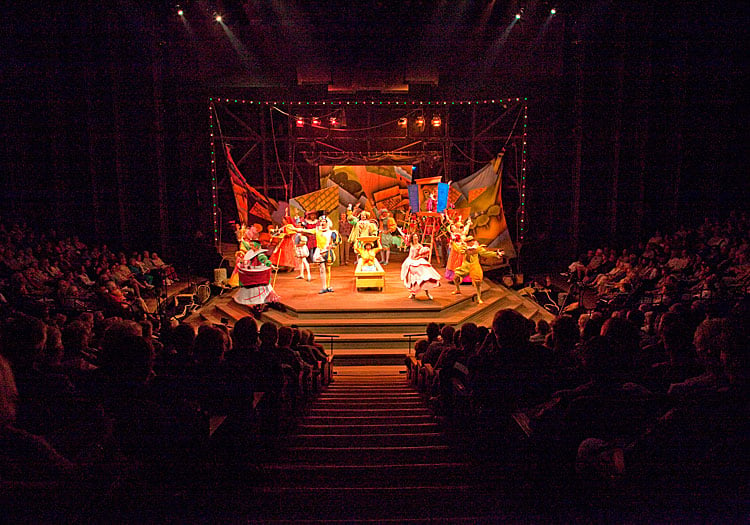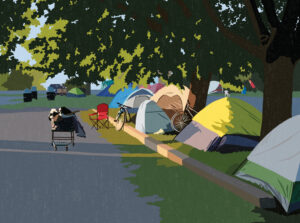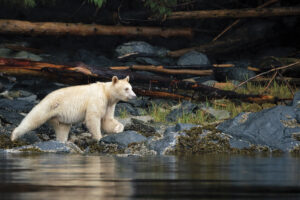
People & Culture
Kahkiihtwaam ee-pee-kiiweehtataahk: Bringing it back home again
The story of how a critically endangered Indigenous language can be saved
- 6310 words
- 26 minutes
This article is over 5 years old and may contain outdated information.
People & Culture


The Stratford Shakespeare Festival is kind of like air, or taxes. Not because you need Canada’s world-renowned classical theatre company in order to live or that it’s a necessary burden for a better society — although arguments could be made — but because now, in its 60th season, the festival has become such a part of the country’s cultural fabric that it’s hard to remember a time when it didn’t exist. Maybe it’s part and parcel of the event’s ability to create illusions, but it can be hard separating the myth from the reality.
Over the years, I’ve gone on a near-annual pilgrimage to the Stratford Festival, usually through school trips or excursions with my family. During these quick sojourns, a hazy notion of the place formed in the backdrop of my mind. For starters, the city seems to exist only when the plays are on and then vanishes, Brigadoonlike, when the final curtain goes down. My impression is that it’s only ever boiling hot in Stratford, because it’s forever August (which is when I and the majority of tourists visit).
Moreover, every second shop is a generalish store that sells some kind of ye olde English merchandise and/or fudge. Plus the locals only speak in Shakespearean iambic pentameter, although since they use blank verse, it can be hard to tell.
None of this is true, it turns out. Or, at least, not entirely. When I arrive in Stratford by train for the final weekend of the season in October, the sun is out, but there’s a crisp chill in the air. The jewelry store on the main drag of Ontario Street does deploy a suit of armor as window dressing, but then there are also Halloween decorations around town, showing that life does exist independently of the festival (albeit still with a love of the theatrical). The black willow trees lining the Avon River, which bisects the city, are showing off their fall colours, and the swans that make their homes on the riverbanks have been picked up and taken to a protected winter retreat. It’s a bit wistful, like a Sunday afternoon before you have to go back to work.
But the theatre festival itself shows no sign of melancholy or even fatigue from having done hundreds of shows during its run, which began in April. It’s still a humming, well-oiled machine as I squeeze into full houses to catch the final performances of a mix of plays representing the modern festival’s program: traditional Shakespeare with Twelfth Night, a crowd-pleasing modern production of The Grapes of Wrath and Harold Pinter’s supremely dark take on the dysfunctional family, The Homecoming. (I passed on the megahit musical Jesus Christ Superstar that went on to Broadway as I’d already seen it earlier in the summer while, naturally, on a visit with my parents.)
Some people would argue that the fall, in fact, is the best time to go the festival. “The shows have developed to their maturity, to the point where the actors are just so into their parts,” says Gerard Brender à Brandis, a printmaker and bookwright who has lived in the city for more than 20 years. “There’s a mellowness, and a beauty to that mellowness.”
With slightly fewer tourists, too, it’s a chance to notice what’s going on behind the scenes of all that beauty and mellowness.
The Stratford Area was settled in the early 1800s, with Ojibwa ceding the boggy land to European immigrants (mostly Scottish, English and German) who were recruited by the Canada Company and driven from their homes by famine and conflict. Despite how tempting it is to think that the town shrewdly adopted its name as a marketing ploy when it launched the theatre festival, when “Stratford” was approved by the directors of the Canada Company, it simply reaffirmed a connection to England.
The city’s appearance is also a reminder of another time. Walking along Ontario Street in downtown Stratford conjures up an old-fashioned air, and it’s not just the novelty stores, such as Macleod’s Scottish Shop. The city declared its downtown a historical district in 1998, preserving some of the circa 1830s buildings, most spectacularly the Queen Anne Revival details in the City Hall that holds court at the intersection of Wellington and Downie.
For all of Stratford’s architectural splendour, what attracted the founders of the theatre festival to the city was less than pretty. Stratford had long been established as a railway hub and was home to a bustling furniture-making industry, but during the Great Depression the city saw its share of turmoil. At one point, troops and tanks were called in to quell striking workers. The town picked up during the economic drive of the Second World War, but post-war Stratford was still grim. A classical festival consisting of strictly Shakespearean plays was local man Tom Patterson’s idea of civic boosterism. (This was only slightly more than a decade after Mickey Rooney and Judy Garland started the “I know, let’s put on a show!” trope in Babes in Arms.)
With sheer chutzpah, Patterson approached Tyrone Guthrie, an English director considered one of the world’s greatest classical theatre directors — he had directed Laurence Olivier in Hamlet. Over the phone, Patterson offered Guthrie $500 to launch a festival in a town he’d never heard of. Slightly miraculously, Guthrie said yes.
The first year was a pioneering affair, with only two Shakespeare plays, Richard III and All’s Well That Ends Well, performed under a giant canvas tent. A pre-Obi Wan Kenobi Alec Guinness played the hunchback king, starting a long tradition of marquee stars in each season. Maggie Smith, James Mason, Peter Ustinov, Paul Gross, Megan Follows and even William Shatner have played at Stratford over the decades; Christopher Plummer, who first appeared as Henry V in 1956, returned this past summer to perform a one-man show about the books that shaped his life, A Word or Two.
Despite the swampy heat of a southern Ontario summer, the first season’s runs sold out, leading to the resolve to make the festival an annual event. Today, the festival has expanded exponentially. It employs about 1,000 people, including 115 actors, roughly three percent of the city’s population, and pumps about $135 million a year into the local economy. This past year, the festival staged more than 600 shows in its four theatres, selling about half a million tickets, some to tourists from as far away as Japan.
Secondary events have sprung up as well, such as tours that take you backstage or through the costume warehouse, a 4,180-square-metre windowless hangar that’s crammed with 65,000 pieces of clothes, shoes and jewelry plus props from productions past and possibly even the Ark of the Covenant, if you know where to look. It’s hard not to get gleeful when the tour concludes with a chance to try on costumes that have been retired from service.
The enduring appeal of the festival is easy to understand, says Antoni Cimolino, who, after seeing a production of Love’s Labour’s Lost at Stratford as a teenager, has spent a lot of his adult life at the festival as an actor and director and currently leads the company as its general director/artistic director designate. “There’s a great power to these plays,” he says. “It’s not just that you get Shakespeare, but he gets you. Not all writers are like that. I mean, Ben Jonson — now, I love Ben Jonson, but he doesn’t make a lot of room for you. He’s there. Whereas Shakespeare has this way of admitting you in. He becomes everybody’s Shakespeare.”
Off the fest ival st ages, an entirely different arts scene thrives in Stratford. In addition to Gallery Stratford, the city’s major exhibition space, dotting Ontario and Downie streets are a half dozen fine art stores covering everything from aboriginal art (Gallery Indigena) to local crafts (Canadian Soul). Working artists aren’t hard to find, either. Potter Mary Philpott’s studio is housed within an annex of the VIA train station, for instance. And then there’s Gerard Brender à Brandis, the printmaker and bookwright who transformed an 1866 saltbox house on Brunswick Street into his work and living space.
From May to October, with his dog Smudge underfoot, Brender à Brandis shows visitors around, demonstrating how he makes his wood engravings, pointing out his ancient yet functioning Albion printing press and leading them through the front parlour used as a gallery and studio space to show off his work, including prints of the flowers mentioned in Shakespeare’s plays.
Born in the Netherlands, Brender à Brandis and his family settled in British Columbia after the Second World War. He eventually moved to Stratford, in part because of the artistic community. “There’s a lot of intellectual and cultural activity in this place,” he says. “The festival is the catalyst that brought all kinds of people here with all kinds of talents, and once here, they started interacting with each other.”
Perhaps the best example of this artistic cross-pollination lies in Stratford’s music scene. Admittedly, the city has recently become known for being the adopted hometown of teen pop juggernaut Justin Bieber. That Bieber’s star plaque is on the walk of fame in front of the Avon Theatre, where he used to busk, while Christopher Plummer’s star is around the corner, is a testimony to the impact Bieber has had in raising Stratford’s international profile. In fact, the Stratford Tourism Alliance is so dedicated to Bieber, they’ve produced a map of the singer’s fave spots, including the schools he attended and the Swiss Chalet his family would visit.
More interesting than early Bieber biography, though, is how live music is almost constantly on tap, often featuring Stratford actors or staff moonlighting their other creative impulses. Lucy Peacock, who’s been acting with the festival company for 25 years, also hosts “Late Nights with Lucy,” a variety-cabaret show that runs most Friday nights in the summer. Even more ambitious is the work being done at a new venue, Factory 163.
From the outside, Factory 163 is a nondescript, threestorey, brown-brick building. But inside, the former furniture manufacturing shop is now a 7,400-square-metre multi-purpose public arts arena with a cozily DIY aesthetic, including a performance space, galleries and room for artists’ studios and workshops. Last year, Stratford Festival director Andrew Shaver programmed a concert series there that featured Sarah Harmer.
“Our vision for the building is an environmentally supportive facility for a creative collective,” says Maryanne Wilson Co, who, with her sister Janet, runs Factory 163. “We’re not limiting the kinds of artists we get. There can be furniture makers or, conceivably, in the future, it could be biologists who are creating something new.”
Geoffrey, much to his delight, is the only one to sign up for a tour of battle fortifications, so he is personally escorted here and there to learn about regency-era military strategy by a perspiring redcoat while I loll in the grass. Swallows dart around the fort’s old stone chapel in the green-gold light of a summer afternoon; the whole place is filled with quiet corners where there is nothing on the wind but birdsong. This peace is its own monument to what the war achieved.
On my final night in Stratford, I attend a concert at Factory 163 and in some ways, it’s the epitome of the cultural fabric the city has spun. Every seat is filled with an all-ages audience raptly listening to a local string quartet called INNER Chamber, who are performing a mix of Beethoven and Czech composer Leo? Janácek. In between the pieces, Stratford Festival actor Irene Poole reads love poems. It’s old work given new life by a contemporary arrangement, with a thread of the great acting company woven in. Clearly it’s time for a new Stratford myth to begin.
Are you passionate about Canadian geography?
You can support Canadian Geographic in 3 ways:

People & Culture
The story of how a critically endangered Indigenous language can be saved

People & Culture
For unhoused residents and those who help them, the pandemic was another wave in a rising tide of challenges

Wildlife
How ‘maas ol, the spirit bear, connects us to the last glacial maximum of the Pacific Northwest

Places
In Banff National Park, Alberta, as in protected areas across the country, managers find it difficult to balance the desire of people to experience wilderness with an imperative to conserve it